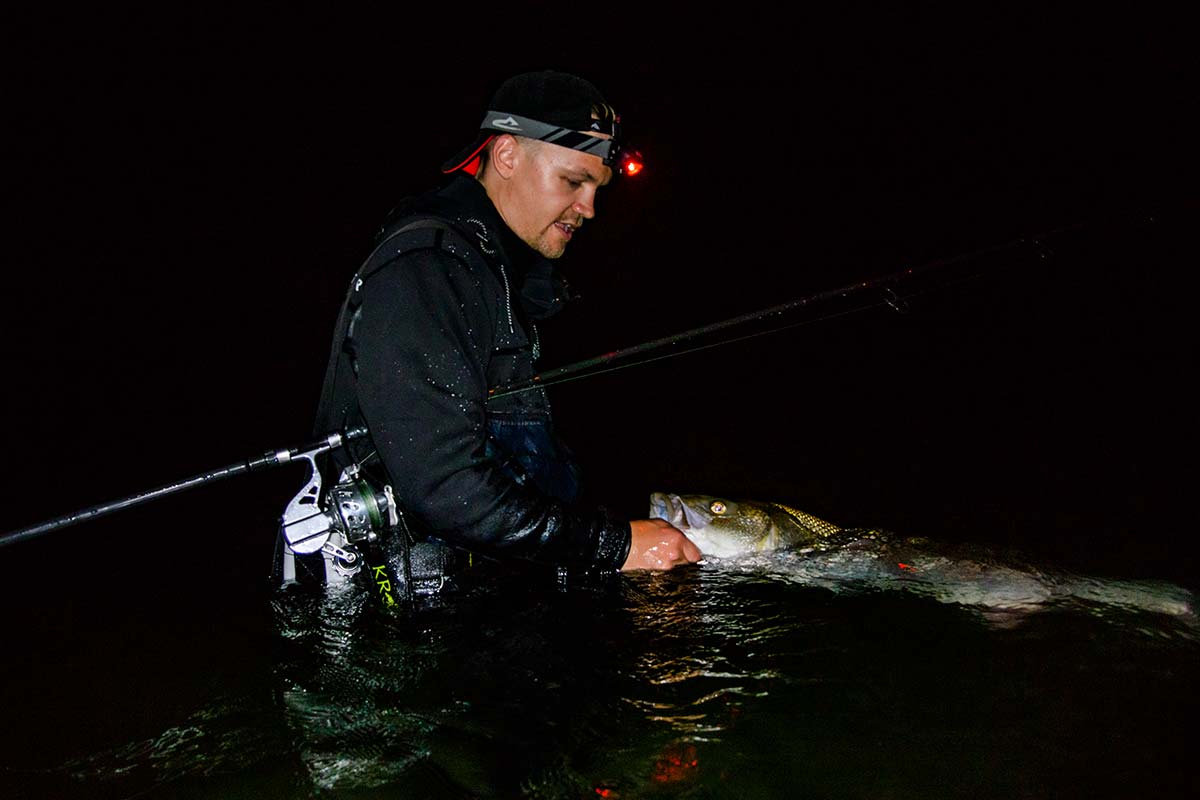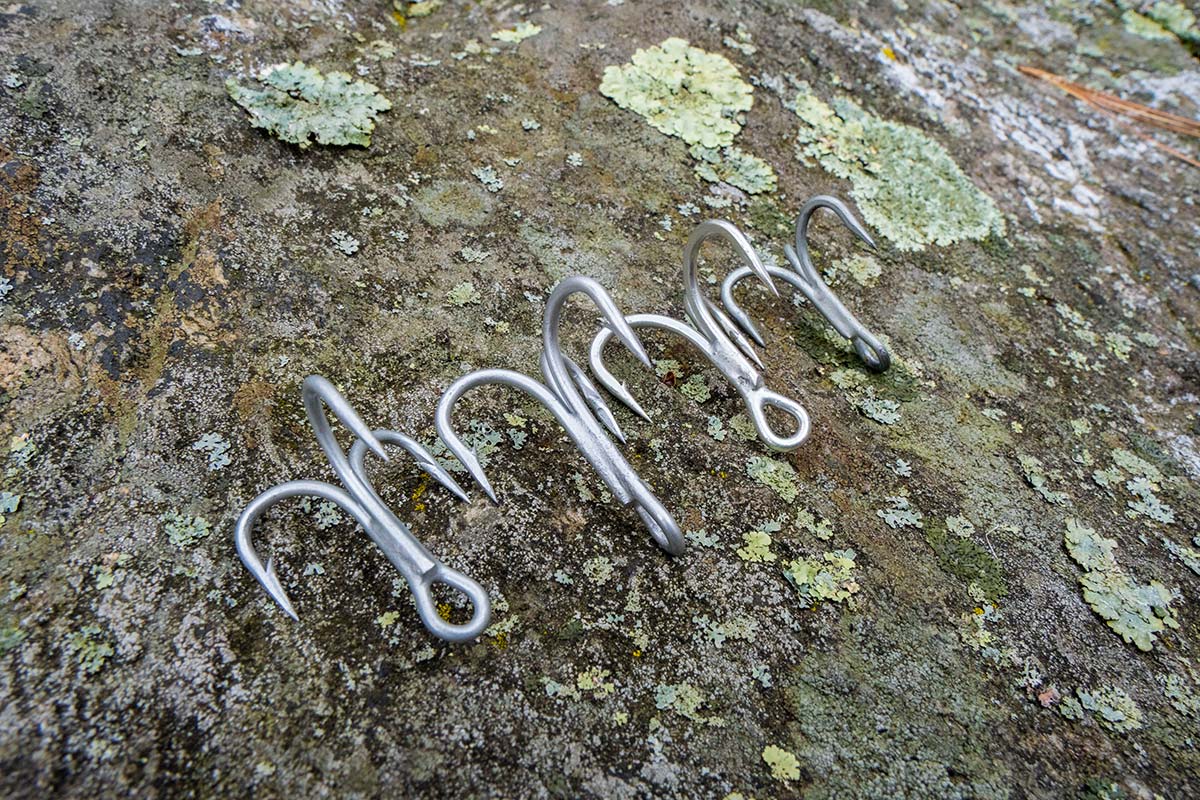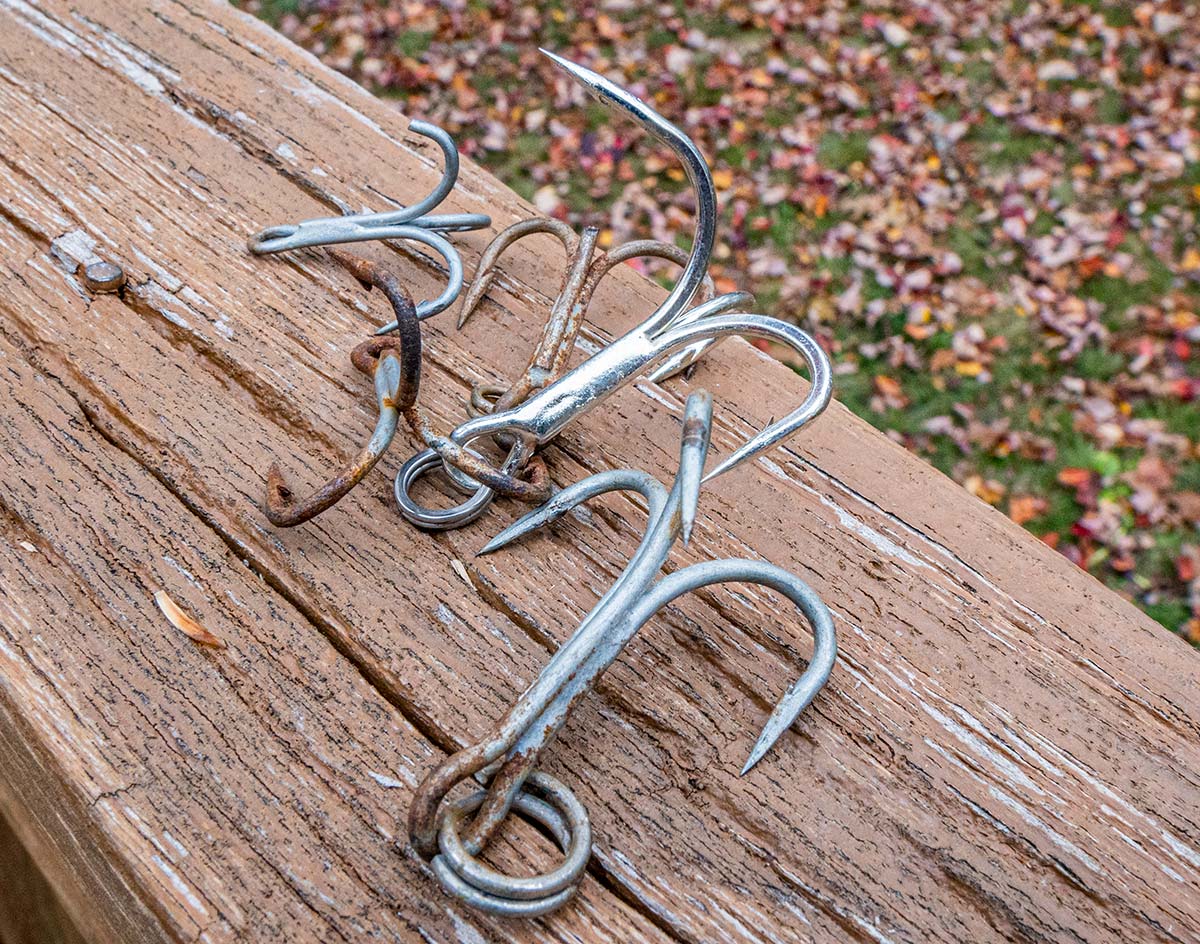
Few things are more frustrating than losing a fish in the midst of a long fight. I hear stories all the time of lost fish, and rarely does anyone mention the hook as being the culprit. However, there are few things more critical in fishing than the hook, and their importance is often dismissed. I suspect many lost fish can be attributed to sloppy terminal gear choices and up-keep; chief amongst them those related to the treble hook.
Hooks are like tires for your car. They often get ignored and there are plenty of cheap, junk options out there. It doesn’t matter how much horsepower your car has, how good your brakes are, or how responsive your steering is if your tires are not grippy and well maintained—you’ll still just end up either peeling out or skidding into a ditch during extreme maneuvers. This is a perfect metaphor for treble hooks. You can have the nicest rod and reel, the best fishing spots, and be a seasoned and serious angler, yet lose fish because your hooks aren’t sharp or strong enough. Even if you maintain your hooks and don’t “cheap out” there are some scenarios where extreme levels of strength are required, most of which typical hooks are simply not designed for. You wouldn’t take an all-season car tire onto a race track, why would you use a stock hook to battle in the Cape Cod Canal?
For this reason, I take hooks seriously and currently rely on four different trebles on my surf plugs. Each of these hooks have strengths and weaknesses which dictates when and how I use them. It’s important to point out that the factors that I may be critical of for each hook may not be a big issue for you, or it might even be a strength for your application. Therefore, I encourage you to think about your typical use and your goals, and decide what will be best for your specific application.
The Standard: VMC 9626 4x Permasteel Short-Shank
I think it’s probably best to use the VMC 9626 hook as the standard comparison for all other hooks in this article. These 4x hooks are used as OEM hardware on several brands of commercial plugs—Super Strike and Gibbs for instance—and they are also used by many custom wood plug builders. These hooks are also the first upgrade many anglers make to lures like the Daiwa SP Minnow or Cotton Cordell Red Fin to make them “surf ready.”
The 9626 VMCs are relatively strong, and they are a fine upgrade to the stock hooks on many saltwater lures. Particularly once you get up and above size 4/0, these hooks become more than strong enough for the vast majority of striped bass applications. They also resist rust relatively well, and although I’ve heard alternate opinions on this, it has been my experience that they resist rusting at least as well if not better than their primary competitor the Mustad 9430s. While you still need to rinse them, you can likely get through a whole season without replacing them if you only fish a couple of days a week. I also find that the VMCs balance better than the Mustads on small plugs that require hooks of size 1/0 or smaller. So if you are using extremely small lures in back-bay applications, I would give the nod to size 1/0-2 VMC hooks versus Mustad 9430 1/0-2.
Their primary weakness, particularly compared to Mustad 9430s, is that they bend under moderate to heavy loads. Specifically in the 1/0 and 2/0 sizes that I use the most, I find I bend hooks more often than acceptable, especially when using a heavy 11-foot rod and 50-pound braid with a tight drag. Again, they are far stronger than most stock hooks, but if you’re a trophy hunter or fish heavy current frequently (e.g. the Canal or major inlets) I would suggest giving the Mustad 9430s a try.

The Heavy Hitter: Mustad 9430 DS 5x DuraSteel
The Mustad 9430 hooks are the hooks I use most in the surf, and they are on approximately 75% of my lures; I call them my “bread and butter” hooks. Four years ago I lost a fish that I felt was entirely due to the weakness in my hook strength; I was using a Red Fin with a 3/0 VMC 9626. I hooked up on this very large fish in moderate current and heavy structure. I knew I was in trouble, so I tightened up my drag to try and prevent the fish from running and breaking me off. The result was a modestly long fight that ended in a bent tine and lost fish. While I had been dabbling in the use of several different hooks at the time, this lost fish pushed me to finally convert to Mustad 9430s almost overnight.
These hooks are much, much stronger than the VMC 9626 hooks. While they say they are 5x and the VMC 9626 are labeled as 4x, I really think of the Mustads as more of a 6x+ hook. This is the whole reason I use them, and I think it overshadows any weakness they may have. They are also less expensive than the VMCs, although it isn’t really enough to make that much of a difference. Just be aware that they are approximately a half to whole size larger than VMCs, and size accordingly on your lures. For example, I use 2/0 9430s where I would use a 3/0 VMC 9626.
However, the Mustads do have several substantial drawbacks. First, they are heavier than the VMCs and most manufacturers do not design their lures to be used with such heavy hooks. Therefore, to get the same action, you often have to go down at least one size. If the lure you’re using is already designed for a 1/0 treble, then going smaller can be a significant detriment to hooking and landing big fish. For this reason, I generally only use them in sizes 1/0-3/0 on lures designed to work with 2/0-5/0 hooks. I don’t even own any 4/0 sized Mustads anymore; they’re just too big and heavy for my applications. Second, and probably the biggest downside overall, is that they are not as sharp as the VMCs. They often need to be touched-up out of the box, and the combination of this and the thick wire (and large barb as a result) means they do not penetrate as easily as the VMCs. This has been an issue for me under some applications, and I believe I have lost several fish on glide baits because of this weakness. Finally, as I mentioned previously, I do not think they hold up as well to rust as the VMCs. But they’re certainly not terrible, and it’s really not that large a difference.
Psycho Sharpness: The Owner ST-66 4x Stinger-66
Let’s get something out of the way right up front: the Owner Stinger-66 hooks are far stronger than the designation 4x implies. Anecdotally, they seem to be every bit as strong for me as the Mustad 9430s, though a bit more brittle. I have yet to bend or break a Stinger-66, and while I don’t have any experience fishing for tuna, I would surmise they would be excellent offshore hooks. Therefore, they’re certainly in the 6x category in my opinion, which is a pretty big upside. That being said, I bought them for one reason only: the almost shocking level of hook penetration these hooks provide. The point taper is much longer than both the VMCs and Mustads reviewed here, and the barb is small. These factors make them almost intimidating to use. These are seriously sharp hooks! I can’t seem to get near them without jabbing myself; “sticky” is the best word I have to describe them. I particularly like them on jerk-bait style lures where I am creating slack in my line by twitching and jerking the lure. Since fish often hit when there is slack after the twitch, I have had trouble getting a firm hook-set. Not anymore! They are truly amazingly sharp. I find myself using these hooks on more and more plugs simply because of this.
However, they also have very serious downsides. First, they are very expensive. They cost over $2 per hook, which is essentially four-times as expensive as the Mustads! This means two hooks can be upwards of 10-30% of the total cost of the lure, and frankly they are just overkill for many situations. Second, they rust quickly. I would put these in the same bin with low-quality OEM hooks found on many lures in terms of rust resistance. Even with regular rinsing, I just can’t keep this going for more than a few months. This, in combination with their up-front cost, makes them prohibitively expensive for many anglers. Therefore, I suggest using them on just those really important plugs you rely on to catch the largest fish. Or, you may even want to consider putting them on only during the most critical tides and moon phases. Still, since surf fishing is so important to me, I do have several plugs that sport these hooks all season: my favorite darter, glide bait, needle, and metal lip always have these hooks hanging from their swivels. The combination of strength and sharpness is worth their shortcomings. Just note, they are also about a half size larger and heavier than the VMC 9626, so they may not work as well on small lures.

Upper Class: VMC 8527 PS 6x Fish Fighter
If there is such a thing as a designer hook, it’s the VMC Fish Fighter. They come in packs of two hooks, and they are marketed as the ultimate treble hook solution for saltwater applications. I bought them initially for the same reasons I now use the Stinger-66 hooks. They are labeled as 6x, which I think is fair, and are made of special Vanadium Steel which is both stronger and more durable than typical steel used in other hooks. They are also extremely resistant to rust.
These hooks hold their point better than the other hooks on this list, without question. While they’re not even close to being as sharp as the Stinger-66s, those hooks can get nicked and blunted if you’re snagging boulders and rocky bottom; the Fish Fighter is far more resistant to this. They also are certainly stronger than the VMC 9626s and are virtually identical in wire diameter and weight. This is a substantial upside if you’re trying to use small lures to catch very large fish; you get an extremely strong hook in a small package (you can order these all the way down to size 8!) I think this is where their largest strength lies: very strong in small sizes.
However, these hooks are brittle. I broke two of them in a single season and I think I’ve only actually broke one other hook ever in my whole surf fishing career, and it was a cheap factory hook. I’ve bent plenty of hooks—I bend a few each season at minimum—but to break a hook is not something I had experienced prior to using these. To be fair, both were under relatively extreme conditions (heavy current and structure) and I still consider them to be very strong. However, in my anecdotal experience, I find they are an “all or nothing” hook; they either hold their shape, or they snap. Also, like the Stinger-66 hooks they are almost $2 a hook, which makes them very expensive compared to the Mustad 9430s or VMC 9626s. For this reason, if you want to go crazy with ultra-high quality hooks, I’d probably give the nod to the Stinger-66 hook over these Fish Fighters in typical surf fishing scenarios. However, if a robust point and rust resistance is more important to you than sharpness, and you’re not a trophy hunter, the Fish Fighters would be a good choice. I do have one specific plastic swimmer that still sports these VMC 8527 hooks because it requires a size 1 treble, yet has caught fish north of 20 pounds. Anglers that love small plastic swimmers should consider these hooks; I’m speaking specifically of the Yo-Zuri Mag Darter.
Again, the specific hook that will work for you really depends on the type of lure you’re using, where you fish, how you fish, your budget, and your goals. Consider all these factors, and decide what makes the most sense for you.





